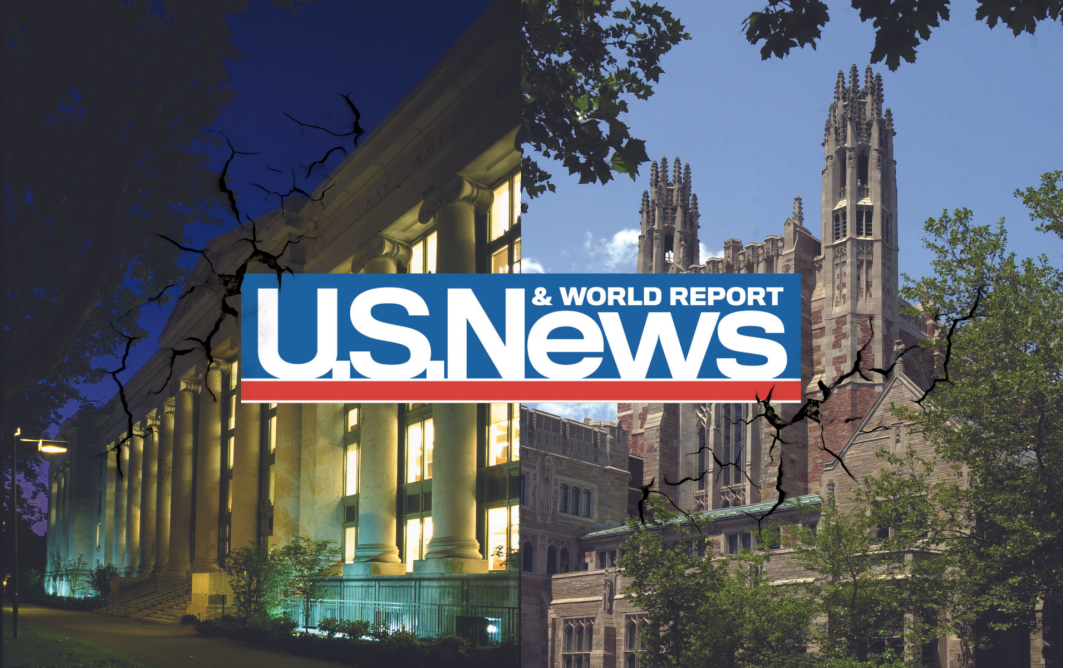A rebellion over U.S. News & World Report’s annual ranking is picking up steam as a number of the nation’s most prestigious law schools have announced they will no longer provide data to the much-watched — and criticized — assessment of law schools.
The law school bases 18% of its ranking on data provided by law schools.
Yale Law School, which routinely ranks No. 1, started the revolt, arguing that the ranking is flawed and hurting legal education because it incentivizes law schools to place too big of a focus on high incoming LSAT and GPA scores at the expense of other factors like diversity and law school missions.
While these are not new arguments, Yale’s move is one of the first concrete actions taken by a high-ranked law school against the magazine and how it assesses performance.
“Leaders in legal education should do everything they can to ensure students of all backgrounds have the support and resources they need to enter our profession and contribute to society,” said Dean Heather Gerken. “Granting exclusive access to a flawed commercial rankings system is counterproductive to the mission of this profession and the core values of Yale Law School.”
Harvard Law School soon followed Yale’s lead, as did a number of others, including Stanford University Law School, Georgetown Law Center, Columbia University and University of California, Berkeley School of Law. Since they are such prestigious schools, it’s a sure bet that no prospective students will shy away because of their stand.
UCLA School of Law also announced it was out, becoming the first school outside of the U.S. News’ top-14 to do so. It’s ranked 15th. University of California, Irvine School of Law and University of California Davis School of law, which are tied in the ranking at 37th, then did the same.
However, other schools may be more hesitant, given how the rankings have such clout and can sway application decisions. A number of schools highlight in their marketing materials where they stand in the rankings.
Sandra Day O’Connor College of Law at Arizona State University notes on its website that it’s ranked 30th, ahead of Boston College Law School and Fordham University School of Law. Both are schools on the other side of the country that would seem to present little competition, except for students who focus on the rankings.
US News said it will continue rank law schools. It released a statement, which, in part read: “We respect each institution’s decision to choose whether or not to submit their data to U.S. News. However, U.S. News has a responsibility to prospective students to provide comparative information that allows them to assess these institutions. U.S. News will therefore continue to rank the nearly 200 accredited law schools in the United States.”
It offered no further comment, so it’s unknown how it will collect data from schools that will not contribute.
U.S. News uses a number of metrics in its ranking. Data that is available from the American Bar Association accounts for 42% of the final ranking. This includes employment success, bar passage rates, LSAT and GPA.
Data that it collects through surveys account for 40% of the ranking — peer, lawyer and judge assessments of the quality of schools.
Data that has previously collected from schools accounts for the remaining 18% of the ranking. This includes average debt (3%) and percent of students incurring debt (2%), student-faculty ratio (2%), average spending on instruction and services (9%), average spending on other items including financial aid (1%), library resources (1%),
Yale has taken issue with a number of the ways U.S. News reaches its findings, including the emphasis on academic strength, reflected by LSAT and GPA scores. That’s about 20% of the weight. To attract students with high LSAT and GPA scores, some schools throw money at them. This, however, comes at the cost of students who need financial aid resources — especially minorities and others from disadvantaged backgrounds.
“While academic scores are an important tool, they don’t always capture the full measure of an applicant,” Gerken said. “This heavily weighted metric imposes tremendous pressure on schools to overlook promising students, especially those who cannot afford expensive test preparation courses.”
Only Yale and Harvard give aid based solely on need, she added.
“These students overcame nearly insurmountable odds to get to Yale, and their stories are nothing short of inspiring. Regrettably, U.S. News has made it difficult for other law schools to eliminate the financial barriers that deter talented minds from joining our profession.”
The boycotting schools hope their actions will get U.S. News to consider changes. Stanford Law School Dean Jenny Martinez said in a statement:
“By joining with the other schools that have chosen to withdraw from participation in the U.S. News rankings this year, we hope to increase the chances that the methodology is seriously overhauled, not only to reduce perverse incentives but to provide clearer and more relevant information that prospective students would find genuinely useful in making decisions about which law schools best match their interests and needs.”
“Perverse incentives” is a term that refers to an incentive that has unintended and harmful consequences. For example, some critics have argued that some law schools have spent more on resources and faculty to help improve their ranking. However, this has unnecessarily increased law school tuition.
Most of the arguments against the ranking are not new. Eight years ago, Anthony Varona, dean of Seattle University School of Law, authored a paper called, “Diversity and Disgrace – How the U.S. News Law School Rankings Hurt Everyone.”
He wrote at the time: “The sad truth is that the U.S. News law school rankings have hurt, and not helped, American law students, the legal profession and, thus, society as a whole. The U.S. News rankings have resulted in the denial of a quality legal education to minority law school applicants with great promise and drive but modest, rankings-unfriendly credentials.”

